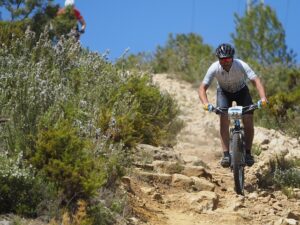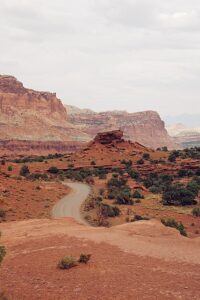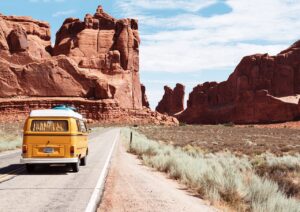Overview & History
Moab, Utah, is a captivating desert town nestled in the heart of the American Southwest, where ancient history, geological wonders, and rugged adventure converge to create an irresistible destination. Founded in the late 19th century, Moab’s origins trace back to the 1850s when Mormon settlers first attempted to establish a trading post along the Old Spanish Trail, though it wasn’t until 1878 that the town was permanently settled, named after the biblical kingdom of Moab, reflecting the region’s arid, biblical-like landscape.
Historically, it evolved from a sleepy agrarian community into a uranium mining boomtown in the 1950s, when the discovery of rich deposits fueled a frenzy that briefly made Moab the “Uranium Capital of the World,” leaving behind a legacy of colorful tales and abandoned mines etched into its red rock canyons. Today, Moab is a vibrant hub drawing over two million visitors annually, lured by its proximity to two of America’s most iconic national parks—Arches and Canyonlands—where millennia-old rock formations, sculpted by wind and water, reveal a geological timeline spanning hundreds of millions of years.
Adventure seekers flock here for world-class mountain biking on the Slickrock Trail, whitewater rafting along the Colorado River, and off-road explorations in a landscape that’s starred in films like *Thelma & Louise* and *Indiana Jones and the Last Crusade*. Beyond its adrenaline-pumping offerings, Moab enchants with its small-town charm, a thriving arts scene bolstered by its annual Moab Arts Festival, and a night sky so pristine it’s certified as an International Dark Sky Park, perfect for stargazing.
With a population of just over 5,000, this former frontier outpost blends its rich past—dotted with Native American petroglyphs from the Ancestral Puebloans and Ute tribes—with a modern allure, making it a must-visit for anyone craving history, nature, and the thrill of the untamed West.
1. Mountain Biking the Slickrock Trail
Imagine pedaling across a surreal moonscape of undulating sandstone, where gravity-defying curves and steep drops test your skills and adrenaline junkies find their paradise—this is the Slickrock Trail, one of the most legendary mountain biking routes in the world.
gravity-defying curves and steep drops test your skills and adrenaline junkies find their paradise—this is the Slickrock Trail, one of the most legendary mountain biking routes in the world.
Spanning 10.5 miles of petrified sand dunes just east of Moab, this trail was originally pioneered by motorcyclists in the 1960s before becoming a mecca for cyclists. Its smooth, grippy rock surface—formed millions of years ago from ancient seabed deposits—offers a rollercoaster-like ride with breathtaking vistas of the La Sal Mountains and the Colorado River below. Riders navigate a series of loops marked by painted white dashes, tackling challenging climbs and heart-pounding descents that demand focus and stamina.
Whether you’re a seasoned pro or a daring beginner (with a rental bike from one of Moab’s many outfitters), the trail’s unique terrain and the rush of conquering it make it an unforgettable thrill, earning it a spot in biking lore and a must-do for any Moab visitor.
2. Whitewater Rafting on the Colorado River Picture yourself gripping a paddle as your raft plunges through churning rapids, surrounded by towering red rock canyon walls that echo with the roar of the river—this is whitewater rafting on the Colorado River near Moab, an exhilarating dance with nature’s raw power.
Picture yourself gripping a paddle as your raft plunges through churning rapids, surrounded by towering red rock canyon walls that echo with the roar of the river—this is whitewater rafting on the Colorado River near Moab, an exhilarating dance with nature’s raw power.
The Westwater Canyon stretch, just upstream from Moab, is a favorite for its Class III and IV rapids, like the notorious “Skull Rapid,” where waves crash and whirlpools swirl, delivering a wild ride through a narrow basalt gorge carved over eons. Guided trips, available from local outfitters, cater to all levels—beginners can opt for gentler sections like the Fisher Towers run, where you’ll float past stunning rock spires while spotting wildlife like bighorn sheep or bald eagles.
The season peaks from spring through early fall, with snowmelt swelling the river into a frothy torrent, though even calmer floats offer scenic splendor. It’s not just the adrenaline; it’s the stories from river guides about ancient Native American sites and outlaw hideouts along the banks that make this a immersive, bucket-list adventure.
3. Off-Roading in Hell’s Revenge
Buckle up for a jaw-dropping off-road escapade on the Hell’s Revenge trail, where you’ll pilot a 4×4 vehicle—or join a guided Hummer tour—over slickrock fins, sandy washes, and near-vertical climbs that feel like defying physics itself. This 6.5-mile trail, located in the Sand Flats Recreation Area, is a rite of passage for off-road enthusiasts, with obstacles like “Hell’s Gate” and “The Devil’s Hot Tub” testing your nerve as you navigate dizzying drops and tight squeezes between rock formations.
you’ll pilot a 4×4 vehicle—or join a guided Hummer tour—over slickrock fins, sandy washes, and near-vertical climbs that feel like defying physics itself. This 6.5-mile trail, located in the Sand Flats Recreation Area, is a rite of passage for off-road enthusiasts, with obstacles like “Hell’s Gate” and “The Devil’s Hot Tub” testing your nerve as you navigate dizzying drops and tight squeezes between rock formations.
The trail’s name isn’t just for show—its rugged terrain, once roamed by uranium prospectors, offers panoramic payoffs with sweeping views of Arches National Park and the distant snow-capped peaks of the La Sal Range.
Along the way, you might spot fossilized dinosaur tracks embedded in the rock, a nod to the prehistoric past beneath your tires. Whether you’re behind the wheel or riding a shotgun, the combination of heart-stopping thrills and otherworldly scenery makes Hell’s Revenge a Moab classic that’s as much about the journey as the bragging rights afterward.
1. Antica Forma Located at 267 North Main Street, Antica Forma brings a slice of Naples, Italy, to the desert heart of Moab with its authentic Neapolitan pizza. This restaurant is a haven for pizza purists, where master pizzaiolo Israel Hernandez, trained by Italian experts, crafts pies using traditional techniques and high-quality ingredients. The dough, made with imported “00” Caputo flour, is fermented for at least 24 hours to enhance flavor, while the sauce bursts with the taste of San Marzano tomatoes grown near Mount Vesuvius.
Located at 267 North Main Street, Antica Forma brings a slice of Naples, Italy, to the desert heart of Moab with its authentic Neapolitan pizza. This restaurant is a haven for pizza purists, where master pizzaiolo Israel Hernandez, trained by Italian experts, crafts pies using traditional techniques and high-quality ingredients. The dough, made with imported “00” Caputo flour, is fermented for at least 24 hours to enhance flavor, while the sauce bursts with the taste of San Marzano tomatoes grown near Mount Vesuvius.
Fresh mozzarella is hand-stretched daily in-house, and the wood-fired oven—shipped straight from Naples—blazes at 800-900°F, delivering a perfectly charred, chewy crust in just minutes. Beyond pizza, the menu features pasta dishes, calzones, and crisp salads, all served in a casual yet classy space with a prominent woodstove anchoring the ambiance. Diners rave about the Funghi and Capanna pies, and the air-conditioned interior offers a welcome respite from Moab’s heat.
Open daily from 11 AM to 9 PM (extending to 10 PM on Sundays and 10:30 PM on Fridays and Saturdays), it’s a must-visit for anyone craving an authentic Italian experience after a day of desert exploration.
2. The Spoke on Center
Situated at 5 North Main Street, The Spoke on Center is a Moab favorite that elevates classic American fare with a touch of sophistication, making it a go-to for hearty meals in a lively, welcoming setting.
elevates classic American fare with a touch of sophistication, making it a go-to for hearty meals in a lively, welcoming setting.
This restaurant excels in burgers—think the Caprese with fresh mozzarella and basil, the Buffalo Bleu with a spicy kick, or the Smokey Shroom loaded with mushrooms and smoky goodness—all crafted with quality ingredients and served alongside some of the best fries in town. The menu doesn’t stop there; appetizers like Moab Sprouts (crisp Brussels sprouts with a local twist) and macaroni poppers add creative flair, while the Cobb salad and hand-scooped ice cream round out a diverse offering.
The covered outdoor patio is a highlight, providing ample shaded seating to enjoy the bustle of downtown Moab, and the interior buzzes with a rustic, down-home vibe—perfect for groups or solo diners fresh off a hike. Open daily from 11:30 AM to 9 PM (closed Sundays), The Spoke pairs its food with a solid cocktail list, making it an ideal spot to unwind and refuel after tackling the trails.
3. Desert Bistro
Tucked away at 36 South 100 West, Desert Bistro offers Moab’s finest dining experience in a charming adobe house just off Main Street, blending Southwestern flair with inventive cuisine. Housed in a historic building, this upscale gem features a seasonal menu that showcases locally sourced ingredients, from game like elk and venison to fresh fish like Chilean seabass, alongside thoughtful vegetarian and vegan options.
experience in a charming adobe house just off Main Street, blending Southwestern flair with inventive cuisine. Housed in a historic building, this upscale gem features a seasonal menu that showcases locally sourced ingredients, from game like elk and venison to fresh fish like Chilean seabass, alongside thoughtful vegetarian and vegan options.
Dishes might include gorgonzola-crusted beef tenderloin or cocoa-crusted venison chop, each plated with artful precision and paired with vibrant vegetables. The in-house baker crafts a rotating dessert lineup that’s as delightful as the mains, and the full bar serves up creative cocktails to sip on the peaceful patio—especially enchanting on warm evenings after sunset.
Open Tuesday through Saturday from 5 PM to 9 PM, Desert Bistro’s intimate indoor seating and twin outdoor terraces create a serene escape from Moab’s adventure-driven pace. It’s pricier and requires reservations, but the exceptional flavors and elegant yet relaxed atmosphere make it a standout for a special night out.
1. Spanish Trail RV Park
Nestled three miles south of downtown Moab on Highway 191, Spanish Trail RV Park is a serene oasis framed by dramatic red rock cliffs and stunning sunsets, earning it rave reviews as a top choice for RV campers. This park prides itself on its meticulously maintained grounds, featuring lush green grass and mature shade trees—a rare treat in the desert—that create a refreshing contrast to the arid surroundings.
Park is a serene oasis framed by dramatic red rock cliffs and stunning sunsets, earning it rave reviews as a top choice for RV campers. This park prides itself on its meticulously maintained grounds, featuring lush green grass and mature shade trees—a rare treat in the desert—that create a refreshing contrast to the arid surroundings.
The sites are spacious, accommodating big rigs with full hookups (30/50-amp electric, water, and sewer), and include pull-through and back-in options, each with a dedicated car parking area. Travelers highlight the cleanliness of the facilities, with spotless bathrooms and a well-kept laundry room, plus the added bonus of pet-friendly spaces complete with a small dog park. The staff, often praised by name (like Loni and her team), go above and beyond, offering warm greetings and insider tips on local dining and attractions like Arches National Park, just a short drive away.
Open year-round, this park books up fast due to its proximity to both national parks and its reputation for exceptional service, making reservations a smart move. It’s an ideal base for those seeking a peaceful retreat with easy access to Moab’s rugged adventures.
2. Moab Rim Campark Perched two miles south of downtown Moab, Moab Rim Campark offers a blend of rustic charm and modern convenience, with unobstructed views of the Spanish Valley and the snow-capped La Sal Mountains. This family-owned park caters to RVers with full-hookup pull-through sites featuring 30/50-amp power, water, sewer, cable TV, and Wi-Fi—perfect for staying connected after a day of exploration.
Perched two miles south of downtown Moab, Moab Rim Campark offers a blend of rustic charm and modern convenience, with unobstructed views of the Spanish Valley and the snow-capped La Sal Mountains. This family-owned park caters to RVers with full-hookup pull-through sites featuring 30/50-amp power, water, sewer, cable TV, and Wi-Fi—perfect for staying connected after a day of exploration.
The newly constructed shower and restroom building is a standout, stocked with convenience items for purchase, while the open, mosquito-free sites provide a breezy, comfortable stay. Nearby hiking and biking trails beckon, and the park’s location—just minutes from Arches National Park—makes it a prime spot for outdoor enthusiasts.
Guests love the laid-back vibe, with picnic tables at each site encouraging al fresco dining under the desert sky. A unique perk: stay six nights, and the seventh is free, adding value to longer visits. Whether you’re in a big rig or a smaller setup, the park’s accessibility and scenic beauty make it a memorable stop for soaking in Moab’s natural splendor.
3. Sun Outdoors Arches Gateway
Formerly known as Moab Valley RV Resort, Sun Outdoors Arches Gateway sits just steps from Arches National Park, offering a resort-style experience with a prime location less than a mile from the park entrance. This park blends natural beauty with upscale amenities, featuring spacious RV sites with full hookups (30/50-amp electric, water, sewer), including pull-through options up to 80 feet for big rigs.
After a day of hiking or biking, unwind in the hot tub, cool off in the swimming pool, or challenge friends to life-size chess and checkers. The gated pool area offers stunning red rock views, while the onsite general store and gas station keep you stocked without leaving the property. Families appreciate the playground and community BBQ spaces, and the park’s proximity to the Colorado River and downtown Moab (within walking or biking distance) adds convenience.
Open year-round, it’s pet-friendly and offers a Park & Play program for repeat visitors, plus discounts like 25% off for stays of three nights or more. Reviewers call it a “gem,” praising the clean facilities and the rainbow-worthy photo ops from the campground, making it a luxurious yet adventure-ready basecamp.
Propane Fill-up in Moab
RV Dump Stations in Moab
1. A History of Moab, Utah by Faun McConkie Tanner
This book is a meticulously crafted historical narrative that chronicles the evolution of Moab from its earliest inhabitants to its mid-20th-century identity. Written by Faun McConkie Tanner, a local historian with deep ties to the region, it begins with the ancient Native American cultures—the Anasazi and Fremont peoples—who left behind traces of their lives in the canyons and rock art around Moab. The story progresses to the arrival of European explorers, including Spanish missionaries traveling the Old Spanish Trail, and the Mormon pioneers who established a trading fort in 1855, only to abandon it after conflicts with local tribes.
Written by Faun McConkie Tanner, a local historian with deep ties to the region, it begins with the ancient Native American cultures—the Anasazi and Fremont peoples—who left behind traces of their lives in the canyons and rock art around Moab. The story progresses to the arrival of European explorers, including Spanish missionaries traveling the Old Spanish Trail, and the Mormon pioneers who established a trading fort in 1855, only to abandon it after conflicts with local tribes.
Tanner details Moab’s founding in 1878 by settlers led by Randolph Hockaday Stewart under Brigham Young’s direction, and its incorporation as a town in 1902. The book vividly describes the town’s transformation through the late 19th and early 20th centuries, spotlighting the arrival of the Denver and Rio Grande Western Railroad in 1883, which spurred economic growth, and the uranium boom of the 1950s that briefly turned Moab into a bustling mining hub. With photographs, maps, and illustrations, Tanner paints a rich picture of key events—like the Elk Mountain Mission’s struggles and the post-World War II tourism surge—while weaving in the stories of the people who shaped Moab’s character.
This facsimile reprint of the original work preserves its cultural importance, offering readers a window into the resilience and spirit of a desert community that evolved from a frontier outpost to a gateway for modern adventurers.
2. Moab, Utah by Day & Night by Grant Collier
This visually stunning book by renowned photographer Grant Collier captures the breathtaking beauty of Moab’s landscapes through a collection of full-color images taken both under the sun and beneath star-filled skies.
Published by Collier Publishing, it showcases the iconic natural wonders surrounding Moab, including the labyrinthine canyons carved by the Green and Colorado Rivers, the sculpted arches and spires of Arches National Park, and the rugged expanse of Canyonlands National Park. Collier, a professional photographer since 1996, brings his expertise in night photography to the forefront, presenting ethereal shots of rock formations silhouetted against the Milky Way—a testament to Moab’s status as an International Dark Sky Park.
The book also features the La Sal Mountains, which loom majestically east of town, and lesser-known gems like Bears Ears, offering a comprehensive visual journey through the region’s diverse terrain. Accompanying the photographs are captions that provide context, blending geological insights with the photographer’s personal experiences exploring Moab’s wilds.
Praised for its flawless reproduction and artistic composition, this 8.5″ x 11″ paperback is both a coffee-table treasure and an inspiration for travelers, appealing to anyone enchanted by the desert’s stark beauty and timeless allure. It’s less a narrative and more a celebration of Moab’s landscapes, making it a perfect companion for those planning a visit or simply dreaming of its vistas.
Final Thoughts for The Smart RVer
Cisco, Utah, stands as a haunting testament to the impermanence of boomtowns, its crumbling shacks and rusted relics whispering tales of a vibrant past along the Denver and Rio Grande Western Railroad. Once a hub for oil, gas, and cattle in the 1920s, it faded into obscurity when I-70 bypassed it, leaving behind an eerie canvas of Mancos Shale and solitude. Today, this ghost town along SR-128 near the Colorado River draws adventurers and photographers with its desolate charm, offering a glimpse into a bygone era where time seems to stand still, interrupted only by the distant rumble of a passing train.
